I have been working on my android projects for years and i am always using this code for database handler to setup sqlite database but these days i installed android studio in new laptop and start to run my projects but i get this error message once app launched:
08-26 13:41:51.044 16032-16032/com.nileworx.flagsquiz E/SQLiteLog: (28) failed to open "/data/data/com.nileworx.flagsquiz/databases/FlagsQuiz" with flag (131072) and mode_t (0) due to error (2)
(14) cannot open file at line 32561 of [a66a5b397b]
(14) os_unix.c:32561: (2) open(/data/data/com.nileworx.flagsquiz/databases/FlagsQuiz) -
08-26 13:41:51.054 16032-16032/com.nileworx.flagsquiz E/SQLiteDatabase: Failed to open database '/data/data/com.nileworx.flagsquiz/databases/FlagsQuiz'.
android.database.sqlite.SQLiteCantOpenDatabaseException: unknown error (code 1294): Could not open database
#################################################################
Error Code : 1294 (SQLITE_CANTOPEN_ENOENT)
Caused By : Specified directory or database file does not exist.
(unknown error (code 1294): Could not open database)
#################################################################
at android.database.sqlite.SQLiteConnection.nativeOpen(Native Method)
at android.database.sqlite.SQLiteConnection.open(SQLiteConnection.java:301)
at android.database.sqlite.SQLiteConnection.open(SQLiteConnection.java:220)
at android.database.sqlite.SQLiteConnectionPool.openConnectionLocked(SQLiteConnectionPool.java:512)
at android.database.sqlite.SQLiteConnectionPool.open(SQLiteConnectionPool.java:206)
at android.database.sqlite.SQLiteConnectionPool.open(SQLiteConnectionPool.java:178)
at android.database.sqlite.SQLiteDatabase.openInner(SQLiteDatabase.java:908)
at android.database.sqlite.SQLiteDatabase.open(SQLiteDatabase.java:878)
at android.database.sqlite.SQLiteDatabase.openDatabase(SQLiteDatabase.java:699)
at android.database.sqlite.SQLiteDatabase.openDatabase(SQLiteDatabase.java:674)
at com.nileworx.flagsquiz.DataBaseHandler.checkDataBase(DataBaseHandler.java:86)
at com.nileworx.flagsquiz.DataBaseHandler.createDataBase(DataBaseHandler.java:47)
at com.nileworx.flagsquiz.DAO.<init>(DAO.java:52)
at com.nileworx.flagsquiz.CustomDialog.<init>(CustomDialog.java:46)
at com.nileworx.flagsquiz.MainActivity.onCreate(MainActivity.java:73)
at android.app.Activity.performCreate(Activity.java:6609)
at android.app.Instrumentation.callActivityOnCreate(Instrumentation.java:1134)
at android.app.ActivityThread.performLaunchActivity(ActivityThread.java:3113)
at android.app.ActivityThread.handleLaunchActivity(ActivityThread.java:3275)
at android.app.ActivityThread.access$1000(ActivityThread.java:218)
at android.app.ActivityThread$H.handleMessage(ActivityThread.java:1744)
at android.os.Handler.dispatchMessage(Handler.java:102)
at android.os.Looper.loop(Looper.java:145)
at android.app.ActivityThread.main(ActivityThread.java:7007)
at java.lang.reflect.Method.invoke(Native Method)
at java.lang.reflect.Method.invoke(Method.java:372)
at com.android.internal.os.ZygoteInit$MethodAndArgsCaller.run(ZygoteInit.java:1404)
This is my DatabaseHandler.java :
package com.nileworx.flagsquiz;
import java.io.FileOutputStream;
import java.io.IOException;
import java.io.InputStream;
import java.io.OutputStream;
import android.content.Context;
import android.database.SQLException;
import android.database.sqlite.SQLiteDatabase;
import android.database.sqlite.SQLiteException;
import android.database.sqlite.SQLiteOpenHelper;
public class DataBaseHandler extends SQLiteOpenHelper {
// The Android's default system path of your application database.
private static String DB_PATH;
private static String DB_NAME = "FlagsQuiz";
private SQLiteDatabase myDataBase;
private final Context myContext;
/**
* Constructor Takes and keeps a reference of the passed context in order to
* access to the application assets and resources.
*
* @param context
*/
public DataBaseHandler(Context context) {
super(context, DB_NAME, null, 1);
this.myContext = context;
DB_PATH = context.getDatabasePath(DB_NAME).toString();
// Log.e("path", DB_PATH);
}
// ==============================================================================
/**
* Creates a empty database on the system and rewrites it with your own
* database.
* */
public void createDataBase() throws IOException {
boolean dbExist = checkDataBase();
if (dbExist) {
// do nothing - database already exist
} else {
// By calling this method and empty database will be created into
// the default system path
// of your application so we are gonna be able to overwrite that
// database with our database.
this.getReadableDatabase();
try {
copyDataBase();
} catch (IOException e) {
throw new Error("Error copying database");
}
}
}
// ==============================================================================
/**
* Check if the database already exist to avoid re-copying the file each
* time you open the application.
*
* @return true if it exists, false if it doesn't
*/
private boolean checkDataBase() {
SQLiteDatabase checkDB = null;
try {
String myPath = DB_PATH;
checkDB = SQLiteDatabase.openDatabase(myPath, null, SQLiteDatabase.OPEN_READONLY);
} catch (SQLiteException e) {
// database does't exist yet.
}
if (checkDB != null) {
checkDB.close();
}
return checkDB != null ? true : false;
}
// ==============================================================================
/**
* Copies your database from your local assets-folder to the just created
* empty database in the system folder, from where it can be accessed and
* handled. This is done by transfering bytestream.
* */
private void copyDataBase() throws IOException {
// Open your local db as the input stream
InputStream myInput = myContext.getAssets().open("database/" + DB_NAME);
// Path to the just created empty db
String outFileName = DB_PATH;
// Open the empty db as the output stream
OutputStream myOutput = new FileOutputStream(outFileName);
// transfer bytes from the inputfile to the outputfile
byte[] buffer = new byte[1024];
int length;
while ((length = myInput.read(buffer)) > 0) {
myOutput.write(buffer, 0, length);
}
// Close the streams
myOutput.flush();
myOutput.close();
myInput.close();
}
// ==============================================================================
public void openDataBase() throws SQLException {
// Open the database
String myPath = DB_PATH;
myDataBase = SQLiteDatabase.openDatabase(myPath, null, SQLiteDatabase.OPEN_READONLY);
}
// ==============================================================================
@Override
public synchronized void close() {
if (myDataBase != null)
myDataBase.close();
super.close();
}
// ==============================================================================
@Override
public void onCreate(SQLiteDatabase db) {
}
// ==============================================================================
@Override
public void onUpgrade(SQLiteDatabase db, int oldVersion, int newVersion) {
}
// Add your public helper methods to access and get content from the
// database.
// You could return cursors by doing "return myDataBase.query(....)" so it'd
// be easy
// to you to create adapters for your views.
}
And this is my database file directory structure :

Manifest file :
<?xml version="1.0" encoding="utf-8"?>
<manifest xmlns:android="http://schemas.android.com/apk/res/android"
xmlns:tools="http://schemas.android.com/tools"
package="com.nileworx.flagsquiz"
android:versionCode="7"
android:versionName="1.0" >
<uses-sdk
android:minSdkVersion="11"
android:targetSdkVersion="18" />
<uses-permission android:name="android.permission.INTERNET" />
<uses-permission android:name="android.permission.ACCESS_NETWORK_STATE" />
<uses-permission android:name="android.permission.RECEIVE_BOOT_COMPLETED" />
<uses-permission android:name="android.permission.VIBRATE" />
<uses-permission android:name="android.permission.WRITE_EXTERNAL_STORAGE" />
<uses-permission android:name="android.permission.READ_EXTERNAL_STORAGE" />
<application
android:allowBackup="true"
android:icon="@drawable/app_icon"
android:label="@string/app_name"
tools:replace="android:label"
android:largeHeap="true"
android:theme="@style/AppTheme" >
<meta-data
android:name="com.google.android.gms.version"
android:value="@integer/google_play_services_version" />
<meta-data
android:name="com.google.android.gms.games.APP_ID"
android:value="@string/app_id" />
<activity
android:name="com.nileworx.flagsquiz.MainActivity"
android:label="@string/app_name"
android:screenOrientation="portrait" >
<intent-filter>
<action android:name="android.intent.action.MAIN" />
<category android:name="android.intent.category.LAUNCHER" />
</intent-filter>
</activity>
<activity
android:name="com.nileworx.flagsquiz.UpdatesDialogActivity"
android:label="@string/app_name"
android:screenOrientation="portrait"
android:theme="@android:style/Theme.Dialog" >
</activity>
<activity
android:name="com.nileworx.flagsquiz.GameActivity"
android:label="@string/app_name"
android:screenOrientation="portrait" >
</activity>
<activity
android:name="com.nileworx.flagsquiz.SettingsActivity"
android:label="@string/app_name"
android:screenOrientation="portrait" >
</activity>
<activity
android:name="com.google.android.gms.ads.AdActivity"
android:configChanges="keyboard|keyboardHidden|orientation|screenLayout|uiMode|screenSize|smallestScreenSize" />
<service android:name="com.nileworx.flagsquiz.GetUpdatesService" >
</service>
<service android:name="com.nileworx.flagsquiz.CheckUpdatesService" >
</service>
</application>
</manifest>
DAO.java
public DAO(Context context) {
dbHandler = new DataBaseHandler(context);
try {
dbHandler.createDataBase();
} catch (IOException ioe) {
throw new Error("Unable to create database");
}
try {
dbHandler.openDataBase();
} catch (SQLException sqle) {
throw sqle;
}
// Log.e("path2",
// context.getDatabasePath("FootballFlagQuiz").toString());
}
Now how can i solve this issue ? Thanks in advance!

